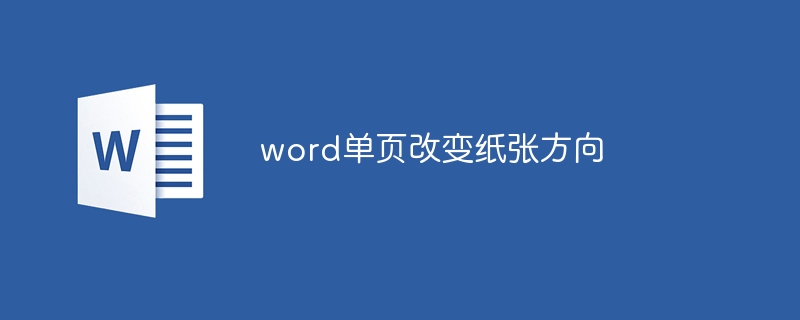Change the paper direction of a single page in word: 1. Select the document paper direction on the interface; 2. Customize page settings; 3. Sectioning function.

When using Microsoft Word to edit documents, sometimes we need to change the paper orientation from portrait to landscape or vice versa. This situation usually occurs when producing documents such as posters, banners, report forms, etc. that require multi-column or large-size layout. This article will introduce how to use Microsoft Word to change the document paper orientation to meet different typesetting needs.
Step one: Select the document paper orientation on the interface
First open the Microsoft Word software and create a new document. By default, Word uses portrait orientation (vertical layout). To change the paper orientation to landscape, follow the steps below.
Select the "Page Layout" tab in the Word menu bar, and find the "Orientation" column in the "Page Setup" group of the tab. Click "Portrait" below the column, and a drop-down option box will appear. Select "Landscape" to change the paper orientation to landscape. Similarly, if you want to change the horizontal orientation to vertical, select the "Portrait" option under the "Orientation" column.
Step 2: Customize page settings
In some cases, Word's default page settings may not meet our needs. In order to better adapt to the layout requirements, we can customize the page settings.
In the "Page Setup" group of the "Page Layout" tab, click the "Paper Size" column, a drop-down menu will pop up, and you can select the preset paper size, such as A4, A3, Letter, etc. . If you need to customize the paper size, select the "More paper sizes" option and the "Page Setup" dialog box will open.
In the "Page Setup" dialog box, click the "Paper" tab to set the width and height of the paper. For example, if you want to set the width to 20 cm and the height to 30 cm, you can set the paper width to 20 cm and the paper height to 30 cm, and then click the "OK" button to save the settings. At this time, the paper size of the document will be typeset according to the customized width and height.
Step 3: Sectioning function
The sectioning function of Word allows us to set different page directions in different parts of the same document to achieve more flexible layout settings.
Click the "Section Break" button in the "Page Layout" tab anywhere in the Word document, and a drop-down menu will pop up. Select "Next Page" to add a section break. Section breaks can divide the document into several sections, and each section can set the page orientation independently.
For example, if you want to set the paper orientation of the first page to portrait and the second page to landscape in a document, we can first insert a section in the page layout symbol, then select portrait orientation on the first page and landscape orientation on the second page. This way, when you print or save the document, the first and second pages will have different page orientations.
Summary:
With the above method, we can easily change the paper orientation of the document in Microsoft Word. These techniques not only apply to single-page documents, but can also be applied to documents with multi-column and large-size formatting. By adjusting paper orientation and customizing page settings, we can better meet different layout needs and improve the readability and beauty of documents. When producing documents such as posters, banners, and report forms, flexible use of these functions will greatly improve work efficiency.
The above is the detailed content of Word single page changes paper orientation. For more information, please follow other related articles on the PHP Chinese website!